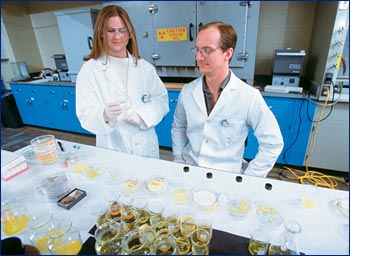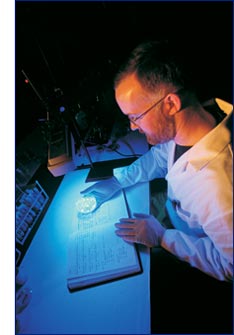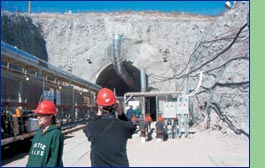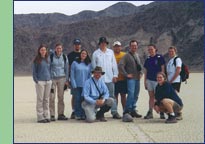|
Environmental Mineralogy
and Nuclear Waste Disposal
During the last five years Peter C. Burns, Massman Associate Professor
of Civil Engineering and Geological Sciences, and his team of researchers
in the Environmental Mineralogy and Crystal Structures Laboratory have
increased the number of known crystal structures of uranium compounds
by approximately 25 percent. They have also increased the number of known
uranium mineral structures by almost 40 percent. This is especially noteworthy
given the emphasis of the research; Burns focuses on the geologic disposal
of nuclear waste and the mobility of actinides in the environment. “We
now have sufficient understanding of the solid phases of uranium,” he
says, “to conduct very specific experiments which can help predict
the mobility of radionuclides in a geologic repository.”
 Funded by the Environmental Management Science Program of the Department
of Energy, Burns’ research is helping to identify how spent nuclear
fuel breaks down over time, what alteration phases form, and how those
alteration phases impact the mobility of radioactive waste. According
to Burns, the most critical step in preventing radionuclides from being
released is understanding and controlling the waste form. If it is a
stable entity, the nuclear waste can sit in the repository for 10,000
years -- the number of years specified by the Nuclear Regulatory Commission
as necessary before a repository can be deemed safe -- without a problem. Funded by the Environmental Management Science Program of the Department
of Energy, Burns’ research is helping to identify how spent nuclear
fuel breaks down over time, what alteration phases form, and how those
alteration phases impact the mobility of radioactive waste. According
to Burns, the most critical step in preventing radionuclides from being
released is understanding and controlling the waste form. If it is a
stable entity, the nuclear waste can sit in the repository for 10,000
years -- the number of years specified by the Nuclear Regulatory Commission
as necessary before a repository can be deemed safe -- without a problem.
“On the other hand,” says Burns, “if the waste forms
are problematic from the start, then safety becomes more a function of
the geology of
the region and the engineered barriers in the repository. The risk of
something going wrong increases considerably.”
Burns and his team have been providing many of the research parameters
for the complex performance assessment models involving a nuclear waste
repository and the geologic area surrounding it, specifically Nevada’s
Yucca Mountain.
Yucca Mountain is currently the only site being considered for development
as the nation’s first long-term geologic repository for high-level
radioactive waste. The physical characteristics of Yucca Mountain that
many researchers cite as favorable for a repository include its distance
from a large population. It is 100 miles from Las Vegas. Nevada’s
dry climate, less than six inches of rainfall a year; an extremely deep
water table, 800 to 1,000 feet below the proposed repository floor; and
the unique combinations of rock around the site have also been identified
as positive and “safe” characteristics. Burns’ focus
has been less on the location and more on getting the storable form of
the nuclear wastes right. “Then,” he says, “everything
else is just a redundant barrier, adding factors of safety.”
 Another project being examined in the Environmental Mineralogy Lab deals
with dioxin-bearing clays, chickens, and farm-raised catfish. Both the
Environmental Protection Agency (EPA) and Georgia-Pacific Corporation
found dioxins in the clay binder of soybean meal used as feed for chickens
and farm-raised catfish. After several months of investigation and extracting
soil from the mine where the clay was taken, the EPA found that the samples
were heavily contaminated with dioxin but were unable to identify its
source. Another project being examined in the Environmental Mineralogy Lab deals
with dioxin-bearing clays, chickens, and farm-raised catfish. Both the
Environmental Protection Agency (EPA) and Georgia-Pacific Corporation
found dioxins in the clay binder of soybean meal used as feed for chickens
and farm-raised catfish. After several months of investigation and extracting
soil from the mine where the clay was taken, the EPA found that the samples
were heavily contaminated with dioxin but were unable to identify its
source.
Dioxins have a congener profile, a fingerprint based upon their atomic
weights. The congener profiles found in the soybean meal did not match
with any known source: Agent Orange, standard pesticides, pulp mill emissions,
etc. However, further studies of clay deposits in the geologic area called
the Mississippi Embayment indicated similar levels of dioxins with the
same general profiles of the dioxins found in the soybean meal.
Burns and his team have a grant from Georgia-Pacific Corporation to identify
the origins of the dioxins. They have begun characterizing the mineralogy
of 40 to 50 samples taken by both Georgia-Pacific and the EPA. “We
are finding that the mineralogy of these dioxin-bearing clays is very
complicated and variable. But we believe there is a correlation between
the dioxin content and the mineralogy,” says Burns. “The
dioxins may have been laid down millions of years ago, or they may have
been introduced through slowly percolating groundwater, which would still
mean they were natural. If they’re not natural, then some as yet
unknown mechanism transported them from the surface into the clay very
rapidly.” According to Burns, unnatural dioxins have only been
in existence for roughly a century. So, if the dioxins are not natural,
there remains an undiscovered geologic process that has modified the
congener profile so it is no longer recognizable. The dioxin project
presents a very interesting question from an organic chemistry and geologic
point of view. |
|
The Debate Over Yucca Mountain
 As part of a course emphasizing regional field geology, students
in the Department of Civil Engineering and Geological Sciences
toured Nevada’s Yucca Mountain facilities during the spring
of 2002. At that time Yucca Mountain had recently received a Presidential
recommendation as the U.S. site for the disposal of 70,000 metric
tons of high-level nuclear waste. The recommendation initiated
an automatic series of events including a congressional review
-- for approval or disapproval; the submission of a con-struction
license to the Nuclear Regulatory Commission (NRC), if approved
by Congress; and a review of the construction license by the NRC,
which can take up to four years. The Department of Energy could
begin construction of the world’s first geologic repository
for high-level nuclear waste upon receiving NRC approval. As part of a course emphasizing regional field geology, students
in the Department of Civil Engineering and Geological Sciences
toured Nevada’s Yucca Mountain facilities during the spring
of 2002. At that time Yucca Mountain had recently received a Presidential
recommendation as the U.S. site for the disposal of 70,000 metric
tons of high-level nuclear waste. The recommendation initiated
an automatic series of events including a congressional review
-- for approval or disapproval; the submission of a con-struction
license to the Nuclear Regulatory Commission (NRC), if approved
by Congress; and a review of the construction license by the NRC,
which can take up to four years. The Department of Energy could
begin construction of the world’s first geologic repository
for high-level nuclear waste upon receiving NRC approval.
Most experts around the world agree that the safest method for disposing
of radioactive waste is to store it deep underground. Based on this
consensus in 1982, Congress passed the Nuclear Waste Policy Act,
which instructed the Department of Energy (DOE) to identify a suitable
site for an underground geologic repository.
In 1983 the DOE targeted nine locations for consideration. Preliminary
studies on each site were reported in 1985, narrowing the field to
three possibilities Hanford, Wash.; Deaf Smith County, Texas; and
Yucca Mountain, Nev. As a result of additional feasibility studies,
Congress amended the Nuclear Waste Policy Act in 1987 when it directed
the DOE to concentrate its site characterization efforts on the Nevada
location.
On February 15, 2002, President Bush notified Congress that he considers
Yucca Mountain qualified for a construction permit application. His
announcement was based on a recommendation by Secretary of Energy
Spencer Abraham and more than 20 years of scientific study demonstrating
the unique characteristics of Yucca Mountain. In his letter to Congressional
leaders, President Bush indicated that proceeding with the Yucca
Mountain project was “necessary to protect public safety, health,
and the nation’s security because successful completion of
this project would isolate in a geologic repository at a remote location
the highly radioactive materials now scattered throughout the nation.”
 The decision on what to do with one of the most dangerous substances
known to man has brought much criticism of the President’s
recommendation. The Sierra Club has urged the President to reject
Yucca Mountain as a possible location, stating that the contamination
of groundwater is a tremendous threat to Nevada residents. Citizen’s
Alert, a 25-year-old grassroots environmental group based in Nevada,
also opposes the use of Yucca Mountain as a nuclear waste repository,
citing a high earthquake probability and the potential for groundwater
contamination as the top two reasons it “is a bad place for
nuclear waste.” The decision on what to do with one of the most dangerous substances
known to man has brought much criticism of the President’s
recommendation. The Sierra Club has urged the President to reject
Yucca Mountain as a possible location, stating that the contamination
of groundwater is a tremendous threat to Nevada residents. Citizen’s
Alert, a 25-year-old grassroots environmental group based in Nevada,
also opposes the use of Yucca Mountain as a nuclear waste repository,
citing a high earthquake probability and the potential for groundwater
contamination as the top two reasons it “is a bad place for
nuclear waste.”
Whether or not Yucca Mountain becomes the nation’s first long-term
nuclear waste repository is uncertain; the debate is still raging.
But there is little doubt about the fact that the future of Yucca
Mountain may well determine the future of nuclear technology in the
United States. |
|
|
 |
 |
 |
 |
 |
| |
|
|

